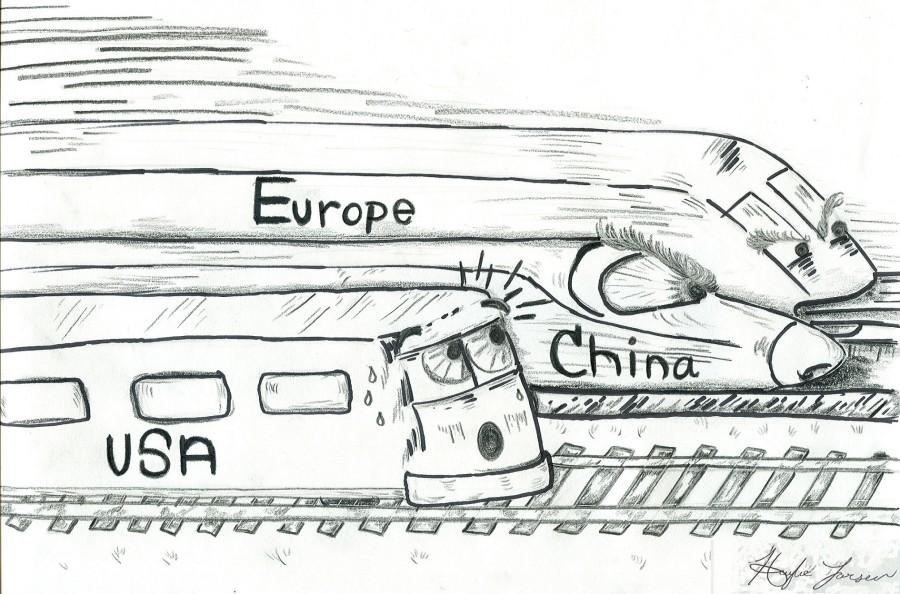The two main transportation systems used in the United States today are notoriously slow. Air travel check in and security is a hassle, while cars are often stuck in traffic. The travel method of the future, the one we should be using, is the same used by most other countries: high speed trains.
Passenger trains in the United States have many benefits but are in desperate need of an update. Between frequent stops and having to share the track with numerous freight trains, passenger trains move far too slowly.
The rest of the world does not have this problem. Countries in Europe and Asia have high speed rail trains which can reach speeds over 200 mph, according to a July issue of Time. A French train recently set the record for speed, moving 357 mph.
These countries recognize the value of train travel. In fact, Spain will invest $200 billion in its high speed rail network by 2020, while China will invest $300 billion, according to Time.
The United States, meanwhile, lacks the extensive high speed rail networks of other countries. Our government has neglected nationwide, intercity passenger rail operator Amtrak and railroads in general for years. While Amtrak received less than $2 billion as its annual federal subsidy last year, the government spent nearly $64 billion on highways, according to Time.
The government needs to focus its resources on train travel. With more federal support, the United States could eventually develop a railway rivaling those in Asia and Europe.
Even without the high speed component, trains have numerous benefits over driving and flying.
“[Trains] are more comfortable and more convenient,” Marc Magliari, Amtrak media relations official, said. “The trains move from downtown to downtown instead of outskirts to outskirts. The fares are understandable, there are no hidden fees, and you can plan ahead for what you’re paying.”
Trains also have more legroom and are more comfortable than cars and planes, and riders can work on a laptop or watch a movie instead of focusing on driving.
Building high speed trains brings even more benefits. They take people places not only much faster than cars, but much faster than the trains we have now, and for less cost than planes. They will also take drivers off the crowded roadways, reducing our dependency on foreign oil.
More and more people in the United States are recognizing these benefits.
“[Amtrak ridership] has been increasing,” Magliari said. “Ridership has gone up for the last three years, first 42 percent, then 14 percent, then 6 percent, and recently has gone up another 50,000 riders.”
Finally, the government has also recognized the benefits. President Obama added $8 billion dollars for high speed rail projects to the stimulus bill in an effort to catch up to the rest of the world.
“There’s no reason China should have the fastest trains,” Obama said in a speech at Carnegie Mellon University last June.
The new high speed rail projects will be concentrated in certain areas as directed by the stimulus, including Florida, California, and Chicago.
“We received $1.2 billion to improve the route between St. Louis and Chicago,” Magliari said. “We’ll be improving the infrastructure, then increasing speed.”
Some may worry about government spending in a down economy, but an investment in high speed rail now will boost the economy later. New infrastructure projects will create jobs, and people skipping vacations due to high airline prices may opt for cheaper train tickets, purchases that will lead to an improved economy.
As a resident of the northwest suburbs of Chicago, one may know the benefits of trains over cars – Metra is the quickest, cheapest, and easiest way to get downtown.
“Metra competes favorably with cars,” Michael Gillis, Metra media relations official, said. “You’re not stuck in traffic jams, you can get downtown quicker, you don’t have maintenance issues and gas bills, and you can make better use of your time.”
Once enough of the rest of the country realizes why we need trains, and more importantly high speed rail, we can improve enough to have a passenger railroad on par with the rest of the world, where we should be.
Public transportation reduces foreign oil dependence
One reason the United States needs high speed rail, and more public transportation in general, is the environment.
Of all the oil we use, 71 percent goes toward transportation, mostly cars, planes, and the like. High speed rail, meanwhile, uses ten times less fuel than cars, and six times less fuel than planes, according to the Midwest High Speed Rail Association.
Less oil used means less drilling and less harm to the environment around the drilling sites. It means less pollution and less dependence on the Middle East.
Even increased use of public transportation, like buses and subways, could help realize this goal, and the addition of high speed rail in the United States will quicken the process.

